PLANTS OF THE MARSHES
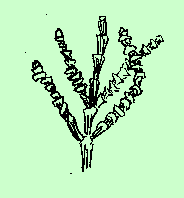 |
Salt grass
(Distichlis stricta): Low perennials with short stiff erect stems. Prominently two-ranked leaves with short blades and overlapping sheaths. Good nesting cover, especially for cinnamon teal. The seeds are sometimes eaten. Makes permanent cover on higher alkali flats. |
|
Glasswort, Pickleweed
(Salicornia spp. and Allenrolfea accidentalis): Erect herb with succulent, branched stems and reduced scale-like leaves. The joints turn reddish with age. Major succulent food, especially for geese. The seeds are valuable to ducks. First invader of damp alkali mud flats. Pickleweed is a member of the Goosefoot Family. Stems of segments are a half inch long. The leaves are reduced to tiny scales (as in many desert plants), which reduces water loss. Photosynthesis is in the stems. From late spring to fall, pickleweed is lush and green. The fleshy stems absorb salt water, but do not excrete salt. Instead, the pressures of salt and stored water build up in the stems until, by fall, the ends of the branches turn pink or red like autumn leaves, dry up, and break off. Pickleweed thrives in soil which contains over six percent salt. Most plants cannot grow -- even those of salt marshes -- if salt concentration is over two percent. (Water flows out of the roots rather than into them.) In Utah, the species are Salicornia rubra, an annual, and Salicornia pacifica, a perennial. |
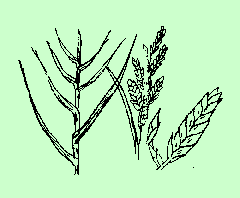
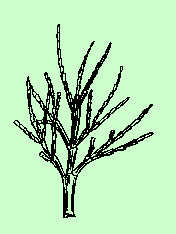 |
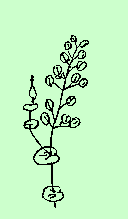 |
Peppergrass
(Lepidium perfoliatum): One to two feet high; very common in spring; skeleton plants stand dry through summer; basal leaves are pinnate, whorled, and turning reddish; upper leaves heart shaped, round and enclosing the wiry, reddish stem. Of little importance to waterfowl. Abundant spring annual on moist higher ground. |
|
Greasewood
(Sarcobatus vermiculatus): A stiff, spiny shrub with nearly smooth branches, numerous leaves. |
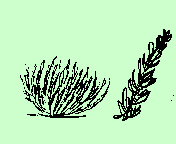 |
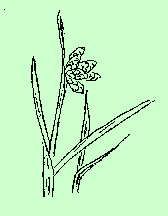 |
Alkali bulrush
(Scirpus paludosus): Valuable nesting cover, seeds valuable food. Tolerant of alkaline mud and water; often the first permanent emergent in newly ponded areas. In brackish or alkaline ponds or marshes. |
|
Sago Pondweed
(Potamogeton pectinatus): Major food for waterfowl, provides seeds, tubers, and green leaves. A recent study of sago pondweed development at Bear River indicated production amounts to 1170 tons of seeds, 3050 tons of tubers, 43,600 tons of vegetation, very tolerant of alkaline and saline waters, with firm soil. |
 |
 |
Widgeongrass
(Ruppia maritima): Leaves thread-like, fruit more or less assymetrical on stalks. Seeds and foliage a staple food. In saline or brackish water, alkaline ponds, lakes, and streams. |
|
Horned Pondweed
(Zannichellis palustris): Stems numerous and thread-like from extensively creeping rootstocks. Fruits in bunches of two to five. Seeds and foliage a staple food. In fresh to alkaline waters, especially where siltation occurs. In lakes, bays, and streams. |
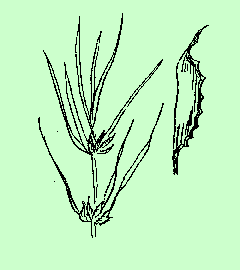 |
 |
Hard-Stem Bulrush
(Scirpus acutus): Preferred nesting cover for redheads and some other ducks. Seeds and sometimes rootstocks are valuable for food. Tolerant of alkaline mud and water; often the first permanent emergent in new ponds. |
|
Cattail
(Typha latifolia): Stems stout, leaves flat, three to six feet tall. Leaves long and flat with sheaths at base; flowers in dense spikes. Valuable nesting cover and muskrat food, but frequently crowds out more valuable plants in waterfowl marshes -- requires control. Usually less tolerant of alkaline and saline conditions than bulrushes. |
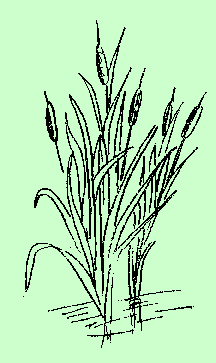 |
 |
Common Reed
(Phragmites communis): Coarse perennials with hard, erect stems. Leaves with long flat blades. Spikelets are plume-like, with long silky hairs. Good nesting cover for yellow-headed blackbirds, of little value to ducks. May crowd out more valuable plants. Along shores of lakes and streams. In fresh water, brackish marshes, and about springs. |
|
Spike Rush
(Eleocharis spp.): Leaves without blades, represented by sheaths at the base of the stem, spikelets solitary, terminating the stems. Seeds, stems and roots used for food by waterfowl. In less saline moist meadows, along with rushes and other sedges. |
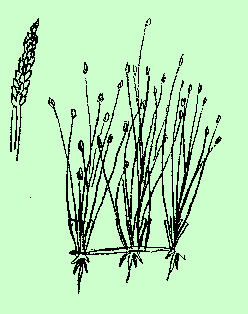 |
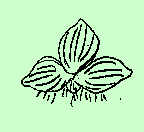 |
Duckweed
(Spirodela polyrhiza, Lemna spp.): Plants minute, free-floating or submersed, without definite leaf or stem. Staple green food. In fresh waters, often rather acid, tolerant of shade. (Duckweed is not found at Bear River.) |
| |
Utah Nature Study Society Fieldtrip Handout - 1965 Prepared by Dot K. Platt |
Adapted for The INTERNET by Sandra Bray |